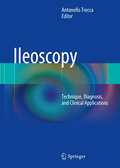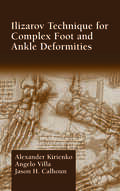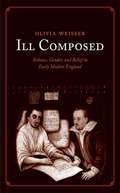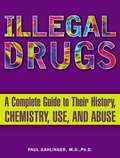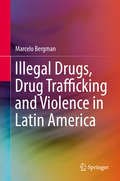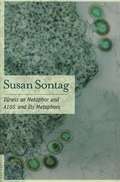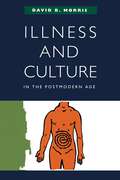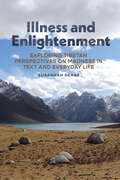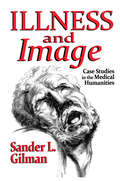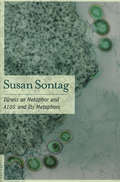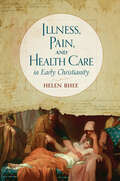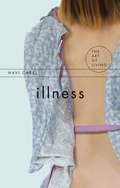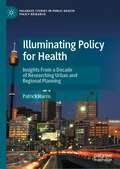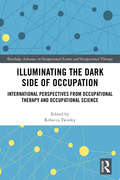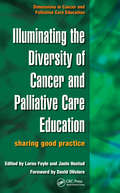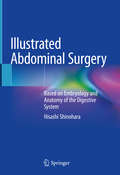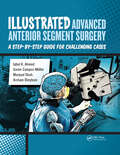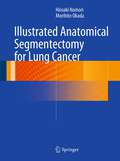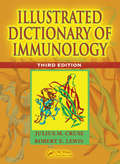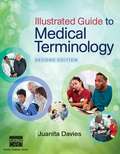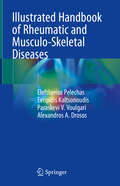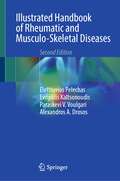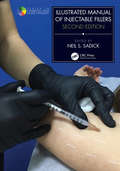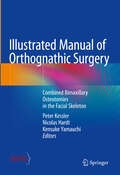- Table View
- List View
Ileoscopy
by Antonello TreccaThis publication is dedicated to all the aspects involved in the endoscopic diagnosis of terminal ileum. The most experienced endoscopists, gastroenterologists and pathologists will focus on and discuss the principles of diagnosis and treatment of the main pathologies involved in this district. The technique of ileoscopy with all the newest advances in endoscopic imaging will be discussed. Another chapter will be dedicated to the possible flow chart of diagnosis of the principles diseases after ileoscopy, from capsule endoscopy to double balloon ileoscopy. A final session will be completely aimed at presenting clinical cases of relevant interest.
Ilizarov Technique for Complex Foot and Ankle Deformities
by Alexander Kirienko Angelo Villa Jason H. CalhounAddressing foot lengthening, metatarsal lengthening, and lengthening of bone stumps of the foot, this reference reveals advanced methods of correcting foot deformities using the Ilizarov technique. Topics span approaches to the equines foot, hindfoot deformities, adduction, the cavus foot, artrorsi, arthrodesis, multi-component foot deformities and
Ill Composed
by Olivia WeisserIn the first in-depth study of how gender determined perceptions and experiences of illness in seventeenth- and eighteenth-century England, Olivia Weisser invites readers into the lives and imaginations of ordinary men and women. Drawing on a wide range of sources, including personal diaries, medical texts, and devotional literature, the author enters the sickrooms of a diverse sampling of early modern Britons. The resulting stories of sickness reveal how men and women of the era viewed and managed their health both similarly and differently, as well as the ways prevailing religious practices, medical knowledge, writing conventions, and everyday life created and supported those varying perceptions. A unique cultural history of illness, Weisser's groundbreaking study bridges the fields of patient history and gender history. Based on the detailed examination of over fifty firsthand accounts, this fascinating volume offers unprecedented insight into what it was like to live, suffer, and inhabit a body more than three centuries ago.
Illegal Drugs
by Paul GahlingerDoes Ecstasy cause brain damage? Why is crack more addictive than cocaine? What questions regarding drugs are legal to ask in a job interview? When does marijuana possession carry a greater prison sentence than murder?Illegal Drugs is the first comprehensive reference to offer timely, pertinent information on every drug currently prohibited by law in the United States. It includes their histories, chemical properties and effects, medical uses and recreational abuses, and associated health problems, as well as addiction and treatment information.Additional survey chapters discuss general and historical information on illegal drug use, the effect of drugs on the brain, the war on drugs, drugs in the workplace, the economy and culture of illegal drugs, and information on thirty-three psychoactive drugs that are legal in the United States, from caffeine, alcohol and tobacco to betel nuts and kava kava.
Illegal Drugs, Drug Trafficking and Violence in Latin America
by Marcelo BergmanThis book describes the main patterns and trends of drug trafficking in Latin America and analyzes its political, economic and social effects on several countries over the last twenty years. Its aim is to provide readers an introductory yet elaborate text on the illegal drug problem in the region. It first seeks to define and measure the problem, and then discusses some of the implications that the growth of production, trafficking, and consumption of illegal drugs had in the economies, in the social fabrics, and in the domestic and international policies of Latin American countries. This book analyzes the illegal drugs problem from a Latin American perspective. Although there is a large literature and research on drug use and trade in the USA, Canada, Europe and the Far East, little is understood on the impact of narcotics in countries that have supplied a large share of the drugs used worldwide. This work explores how routes into Europe and the USA are developed, why the so-called drug cartels exist in the region, what level of profits illegal drugs generate, how such gains are distributed among producers, traffickers, and dealers and how much they make, why violence spread in certain places but not in others, and which alternative policies were taken to address the growing challenges posed by illegal drugs. With a strong empirical foundation based on the best available data, Illegal Drugs, Drug Trafficking and Violence in Latin America explains how rackets in the region built highly profitable enterprises transshipping and smuggling drugs northbound and why the large circulation of drugs also produced the emergence of vibrant domestic markets, which doubled the number of drug users in the region the last 10 years. It presents the best available information for 18 countries, and the final two chapters analyze in depth two rather different case studies: Mexico and Argentina.
Illness As Metaphor, and AIDS and Its Metaphors
by Susan SontagIn l978 Susan Sontag wrote Illness as Metaphor, a classic work described by Newsweek as "one of the most liberating books of its time." A cancer patient herself when she was writing the book, Sontag shows how the metaphors and myths surrounding certain illnesses, especially cancer, add greatly to the suffering of the patients and often inhibit them from seeking proper treatment. By demystifying the fantasies surrounding cancer, Sontag shows cancer for what it is - just a disease. Cancer, she argues, is not a curse, not a punishment, certainly not an embarrassment, and highly curable, if good treatment is found early enough. Almost a decade later, with the outbreak of a new, stigmatized disease replete with mystifications and punitive metaphors, Sontag wrote a sequel to Illness as Metaphor, extending the argument of the earlier book to the AIDS pandemic. These two essays, published together as Illness as Metaphor and Aids and Its Metaphors, have been translated in many languages all over the world, and continue to have enormous impact and influence on the thinking of medical professionals and, above all, on the lives of many thousands of patients and caregivers.
Illness and Culture in the Postmodern Age
by David B. MorrisWe become ill in ways our parents and grandparents did not, with diseases unheard of and treatments undreamed of by them. Illness has changed in the postmodern era—roughly the period since World War II—as dramatically as technology, transportation, and the texture of everyday life. Exploring these changes, David B. Morris tells the fascinating story, or stories, of what goes into making the postmodern experience of illness different, perhaps unique. Even as he decries the overuse and misuse of the term "postmodern," Morris shows how brightly ideas of illness, health, and postmodernism illuminate one another in late-twentieth-century culture.Modern medicine traditionally separates disease—an objectively verified disorder—from illness—a patient's subjective experience. Postmodern medicine, Morris says, can make no such clean distinction; instead, it demands a biocultural model, situating illness at the crossroads of biology and culture. Maladies such as chronic fatigue syndrome and post-traumatic stress disorder signal our awareness that there are biocultural ways of being sick.The biocultural vision of illness not only blurs old boundaries but also offers a new and infinitely promising arena for investigating both biology and culture. In many ways Illness and Culture in the Postmodern Age leads us to understand our experience of the world differently.
Illness and Enlightenment: Exploring Tibetan Perspectives on Madness in Text and Everyday Life
by Susannah DeaneTibetan understandings of nyoné — ‘madness’— encompass a broad range of concepts. Perspectives on the causation and treatment of madness as an illness are informed by Tantric and medical understandings of mind-body structure and (dys)functioning, as well as people’s relationships with non-human entities. In addition, ‘madness’ may be seen as a sign of enlightenment in the case of some Tantric practitioners. Based on ethnographic fieldwork in the Tibetan region of Amdo in northwest China, as well as examination of Tibetan medical and religious texts, Illness and Enlightenment explores the multi-faceted concept of nyoné through key Tibetan concepts of wind, heart, and mind, as well as human-spirit relationships.
Illness and Image: Case Studies in the Medical Humanities
by Sander L. GilmanThe humanities in higher education are too often labeled as impractical and are not usually valued in today's marketplace. Yet in professional fields, such as the health sciences, interest in what the humanities can offer has increased. Advocates claim the humanities offer health care professionals greater insight into how to work with those who need their help.Illness and Image introduces undergraduates and professionals to the medical humanities, using a series of case studies, beginning with debates about male circumcision from the ancient world to the present, to the meanings of authenticity in the face transplantation arena. The case studies address the interpretation of mental illness as a disability and the "new" category of mental illness, "self-harm." Sander L. Gilman shows how medicine projects such categories' existence into the historical past to show that they are not bound in time and space and, therefore, are "real."Illness and Image provides students and researchers with models and possible questions regarding categories often assumed to be either trans-historical or objective, making it useful as a textbook.
Illness as Metaphor and AIDS and Its Metaphors (Penguin Modern Classics Ser.)
by Susan SontagIn 1978 Susan Sontag wrote Illness as Metaphor, a classic work described by Newsweek as "one of the most liberating books of its time." A cancer patient herself when she was writing the book, Sontag shows how the metaphors and myths surrounding certain illnesses, especially cancer, add greatly to the suffering of patients and often inhibit them from seeking proper treatment. By demystifying the fantasies surrounding cancer, Sontag shows cancer for what it is--just a disease. Cancer, she argues, is not a curse, not a punishment, certainly not an embarrassment and, it is highly curable, if good treatment is followed. Almost a decade later, with the outbreak of a new, stigmatized disease replete with mystifications and punitive metaphors, Sontag wrote a sequel to Illness as Metaphor, extending the argument of the earlier book to the AIDS pandemic.These two essays now published together, Illness as Metaphor and AIDS and Its Metaphors, have been translated into many languages and continue to have an enormous influence on the thinking of medical professionals and, above all, on the lives of many thousands of patients and caregivers.
Illness, Pain, and Health Care in Early Christianity
by Helen RheeWhat did pain and illness mean to early Christians? And how did their approaches to health care compare to those of the ancient Greco-Roman world? In this wide-ranging interdisciplinary study, Helen Rhee examines the ways early Christians viewed illness, pain, and health care—and how they were influenced both by their own tradition and by the milieu of the larger ancient world. Throughout the book, Rhee places the history of medicine, Greco-Roman literature, and ancient philosophy in fruitful dialogue with early Christian literature and theology to show the nuanced ways Christians understood, appropriated, and reformulated Roman and Byzantine conceptions of health and wholeness from the second through the sixth centuries CE. Utilizing the contemporary field of medical anthropology, Rhee engages illness, pain, and health care as sociocultural matters. Through this and other methodologies, she explores the theological meanings attributed to illness and pain; the religious status of those suffering from these and other afflictions; and the methods, systems, and rituals that Christian individuals, churches, and monasteries devised to care for those who suffered. Rhee&’s findings ultimately provide an illuminating glimpse into an instrumental way that Christians began shaping a distinct identity—both as part of and apart from their Greco-Roman world.
Illness: The Cry of the Flesh
by Havi CarelIn this remarkable and thought-provoking book, Havi Carel explores these questions by weaving together the personal story of her own serious illness with insights and reflections drawn from her work as a philosopher. Carel's fresh approach to illness raises some uncomfortable questions about how we all - whether healthcare professionals or not - view the ill and challenges us to become more thoughtful. 'Illness' unravels the tension between the universality of illness and its intensely private, often lonely, nature. It offers a new way of looking at a matter that affects every one of us.
Illuminating Colorectal Cancer Genomics by Next-Generation Sequencing: A Big Chapter in the Tale
by Khalid El BairiThis book reviews the potential of next-generation sequencing (NGS) in research on and management of colorectal cancer (CRC), a leading cause of death worldwide and one of the most biologically and clinically heterogeneous cancers. It critically discusses findings from recent large-scale studies, clinical trials and meta-analyses and offers an introduction to the management of CRC in the era of precision medicine. In CRC, dozens of driver and passenger mutations are associated with the malignant transformation of epithelial cells. Consequently, the book discusses recent advances in our understanding of the genetics of CRC as a biomarker, the advent of NGS technologies in modern genomics, and the impact of NGS technology on the management of CRC. Furthermore, it highlights the potential of NGS in the context of liquid biopsy and single-cell sequencing in CRC, as well as its role in shedding light on the link between gut microbiota, immune-checkpoint blockade and CRC. The book concludes with a chapter on the limitations and cost-effectiveness of NGS in CRC. Given its scope, the book will appeal to all those interested in learning about the potential of NGS in advancing CRC research and patient care.
Illuminating Policy for Health: Insights From a Decade of Researching Urban and Regional Planning (Palgrave Studies in Public Health Policy Research)
by Patrick HarrisThis book unpacks policy and politics for health, equity, and wellbeing. With a critical realist lens, the book provides a methodology for sophisticated health focussed policy analysis which situates public health within complex political processes and systems. The application of that lens is demonstrated with insights from a decade of research into urban and regional planning.
Illuminating The Dark Side of Occupation: International Perspectives from Occupational Therapy and Occupational Science (Routledge Key Themes in Health and Society)
by Rebecca TwinleyThis innovative volume introduces Twinley’s concept of ‘The Dark Side of Occupation’. Focused on less explored and under-addressed occupations, it is an idea which challenges traditional assumptions around the positive, beneficial, health-promoting relationship between occupation and health. Emphasising that people’s individual experiences of occupations are not always addressed and may not always be legal, socially acceptable, or conducive to good health, the book investigates how these experiences can be explored theoretically, in practice and research, and in curriculum content for those learning about occupation. Beginning with a discussion of some assumptions and misunderstandings that have been made about the concept, the substantive chapters present and analyse tangible examples of the concept’s applicability. This ground-breaking and practice-changing text provides ideas for future research and highlights contemporary, internationally relevant issues and concerns, such as the coronavirus pandemic. This book is an essential purchase for students in occupational therapy and science, and valuable supplementary reading for practitioners. It is also relevant to a wide interdisciplinary audience with an interest in human occupation, encompassing anthropologists, councillors, criminologists, nurses, and human geographers.
Illuminating the Diversity of Cancer and Palliative Care Education: A Complete Resource for EMQs & a Complete Resource for MCQs, Volume 1 & 2
by Lorna Foyle Janis HostadIlluminating the Diversity of Cancer and Palliative Care Education examines a myriad of original approaches, techniques, methods, educational strategies and imaginative innovations within this vital field of medicine. Its contributors share a range of educational techniques and tactics from Neuro-Linguistic Programming to creative teaching strategies for bereavement support, allowing readers to reflect on best practice and inventive ways of working which can be used or adapted to suit. This book is an ideal companion to its sister volumes Innovations in Cancer and Palliative Care Education and Delivering Cancer and Palliative Care Education.
Illustrated Abdominal Surgery: Based on Embryology and Anatomy of the Digestive System
by Hisashi ShinoharaThis comprehensive, illustrated guide presents representative general surgery, including gastrointestinal tract, hepatobiliary and inguinal hernia. Surgery is generally based on the microanatomy; however, in practice surgery involves more dynamic and floating anatomy. In the last decade, the methods have been constantly improved, shedding new light on classical anatomical science. Laparoscopic is one such methodology. All illustrations presented in this book have been drawn by the author – a pioneering surgeon – and show real-world procedures. All the methods introduced are practical and have been refined based on the precise clinical and embryological anatomy. This unique book offers readers essential insights into efficient and high-integrity surgeries in abdominal region. As such, it is a valuable resource for all gastrointestinal surgeons.
Illustrated Advanced Anterior Segment Surgery: A Step-by-Step Guide for Challenging Cases
by Arsham Sheybani Iqbal Ahmed Xavier Möller Manjool ShahFor general ophthalmologists looking to expand their surgical skillsets, anterior segment surgery specialists wishing to learn new techniques, and residents looking to separate themselves from the pack, Illustrated Advanced Anterior Segment Surgery: A Step-by-Step Guide for Challenging Cases is a must-have resource. The book provides a wide range of advanced anterior segment surgery techniques, presented in a highly designed graphic style. Editors Iqbal “Ike” Ahmed, Xavier Campos-Möller, Manjool Shah, and Arsham Sheybani have created a dynamic visual guide that emphasizes images and diagrams and includes step-by-step illustrations to help readers understand the optimal hand positions for certain surgical maneuvers. Each chapter focuses on an individual technique, allowing readers to consult specific chapters as needed. There is significant emphasis on both foundational concepts and advanced surgical techniques, including: Ergonomics, hand positioning, and instrument grips How to insert and remove iris hooks Capsulorhexis in the setting of weak zonules How to perform intrascleral haptic fixation of a three-piece IOL How to repair an iridodialysis cleft With its unique graphic approach and easily digestible format, Illustrated Advanced Anterior Segment Surgery: A Step-by-Step Guide for Challenging Cases will help surgeons take their skills to the next level and tackle some of the most challenging cases in anterior segment surgery.
Illustrated Anatomical Segmentectomy for Lung Cancer
by Hiroaki Nomori Morihito OkadaAdvances in CT have enabled us to detect small lung cancers, which has changed the lung cancer surgery from lobectomy to a lesser lobar resection such as a segmentectomy or wedge resection. While wedge resection is a simple procedure, it has a higher risk of local recurrence of cancer than a lobectomy. On the other hand, segmentectomy is a well known curative surgery for small lung cancers. However, it is difficult to perform accurately because of its anatomical complexity, which makes surgeons hesitant to use it. The book "Illustrated Anatomical Segmentectomy for Lung Cancer" provides readers a detailed explanation of segmentectomy with numerous easy-to-understand color illustrations showing the precise segmental anatomies for each pattern of the procedure. To better illustrate an accurate anatomical segmentectomy, the text shows details of anatomy during segmentectomy. This can involve up to 25 patterns, each of which is shown in roughly 10 illustrations.
Illustrated Dictionary of Immunology
by Julius M. Cruse Robert E. LewisFrom the beginning, immunologists have maintained a unique nomenclature that has often mystified and even baffled their colleagues in other fields, causing them to liken immunology to a black box. With more than 1200 illustrations, the Illustrated Dictionary of Immunology, Third Edition provides immunologists and nonimmunologists a single-volume resource for the many terms encountered in contemporary immunological literature. Encyclopedic in scope and including more than 1200 illustrations, the content ranges from photographs of historical figures to molecular structures of recently characterized cytokines, the major histocompatibility complex molecules, immunoglobulins, and molecules of related interest to immunologists. These descriptive illustrations provide a concise and thorough understanding of the subject. To reflect modern advances, the third edition includes entries on immunopharmacology, newly described interleukins, comparative immunology, immunity to infectious diseases, and expanded definitions in all of the immunological subspecialities. Providing unprecedented breadth and detail, this readily accessible book is not only a pictorial reference but also a primary resource.
Illustrated Guide to Medical Terminology (Mindtap Course List Series)
by Juanita J. DaviesThe text teaches fundamental medical terms using word parts, without bogging down in detailed anatomy and physiology discussions. A highly visual approach--with abundant use of tables, charts, and illustrations--makes the text an effective resource for readers of diverse backgrounds, including ESL speakers, individuals focused on career preparation, and auditory and visual learners.
Illustrated Handbook of Rheumatic and Musculo-Skeletal Diseases
by Eleftherios Pelechas Evripidis Kaltsonoudis Paraskevi V. Voulgari Alexandros A. DrososIllustrated Handbook of Rheumatic and Musculo-Skeletal Diseases
Illustrated Handbook of Rheumatic and Musculo-Skeletal Diseases
by Eleftherios Pelechas Evripidis Kaltsonoudis Paraskevi V. Voulgari Alexandros A. DrososThis book comprehensively reviews clinical aspects and features of rheumatic and musculo-skeletal diseases in an integrated and easy to read format. It enables the reader to become confident in identifying common and unusual disease symptoms and be able to apply a variety of diagnostic modalities and evaluate potential treatment options. Every disease covered has a variety of clinically relevant images detailing both typical and rare signs and symptoms. Each image is accompanied by a detailed description covering relevant epidemiological data, diagnostic modalities and treatment options. The Illustrated Handbook of Rheumatic and Musculo-Skeletal Diseases, 2ndEdition has been fully revised with new content and clinical photographs throughout each chapter. Rheumatologists seeking a comprehensive and clinically relevant guide for the diagnosis and treatment of a broad range of rheumatic and allied diseases will find this book to be an essential resource in their daily clinical practice.
Illustrated Manual of Injectable Fillers (Series in Cosmetic and Laser Therapy)
by Neil S. SadickThis practical text clearly evaluates the uses, limitations, and compositions of the growing variety of available fillers involved in face and body rejuvenation. It includes detailed techniques for facial analysis and diagnosis of aging conditions to help provide patients with safe, reliable, and aesthetically pleasing results, including preventing and properly treating potential complications of filler usage. With new chapters on limb and torso injections and combination treatments, this new edition will be an invaluable resource for all aesthetic practitioners.
Illustrated Manual of Orthognathic Surgery: Combined Bimaxillary Osteotomies in the Facial Skeleton
by Nicolas Hardt Peter Kessler Kensuke YamauchiThe third volume of a multi-volume series considers the gain in experience and knowledge in orthognathic surgery through preoperative 3D planning and postoperative control using established and new clinical protocols in orthognathic maxillofacial surgery. Standard techniques in orthognathic oral and maxillofacial surgery are contrasted with alternatives based on years of experience and knowledge. Orthognathic oral and maxillofacial surgery has experienced a renaissance in recent years, mainly due to three-dimensional radiologic imaging, digital planning and computer-aided manufacturing techniques. The book is deliberately structured in such a way that the clinical situation is supplemented with graphic illustrations for better understanding, which are intended to point out special situations that can in turn positively influence the surgical planning of the procedure in order to avoid undesirable results in individual cases. Volume III deals with the bimaxillary approach for the correction of facial deformities. The book will have a reduced text section but with many clinical images to show the logic of the surgical approach in a simple and clear way to the surgeon who is image-oriented. Illustrations must help where radiological images fail. The structure of the book will nevertheless be classic, as the variations of the established techniques can only be understood on the basis of historical development. A corresponding book that combines clinical situations with pre- and postoperative radiological and clinical evaluation and graphic explanation does not exist to date. It will appeal to a broad readership of students and professionals working within Oral and Maxillofacial Surgery, Orthodontics, Plastic and Craniofacial Surgery, and Otorhinolaryngology.
